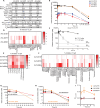Structure-based discovery of highly bioavailable, covalent, broad-spectrum coronavirus MPro inhibitors with potent in vivo efficacy
- PMID: 40267184
- PMCID: PMC12017303
- DOI: 10.1126/sciadv.adt7836
Structure-based discovery of highly bioavailable, covalent, broad-spectrum coronavirus MPro inhibitors with potent in vivo efficacy
Abstract
The main protease (MPro) of severe acute respiratory syndrome coronavirus 2 (SARS-CoV-2) is a validated drug target. Starting with a lead-like dihydrouracil chemotype identified in a large-library docking campaign, we improved MPro inhibition >1000-fold by engaging additional MPro subsites and using a latent electrophile to engage Cys145. Advanced leads from this series show pan-coronavirus antiviral activity, low clearance in mice, and for AVI-4773, a rapid reduction in viral titers >1,000,000 after just three doses. Both compounds are well distributed in mouse tissues, including brain, where concentrations >1000× the 90% effective concentration are observed 8 hours after oral dosing for AVI-4773. AVI-4516 shows minimal inhibition of major cytochrome P450s and human proteases. AVI-4516 also exhibits synergy with the RNA-dependent RNA polymerase inhibitor, molnupiravir, in cellular infection models. Related analogs strongly inhibit nirmatrelvir-resistant MPro mutant virus. The properties of this chemotype are differentiated from existing clinical and preclinical MPro inhibitors and will advance therapeutic development against emerging SARS-CoV-2 variants and other coronaviruses.
Figures





References
-
- Owen D. R., Allerton C. M. N., Anderson A. S., Aschenbrenner L., Avery M., Berritt S., Boras B., Cardin R. D., Carlo A., Coffman K. J., Dantonio A., Di L., Eng H., Ferre R. A., Gajiwala K. S., Gibson S. A., Greasley S. E., Hurst B. L., Kadar E. P., Kalgutkar A. S., Lee J. C., Lee J., Liu W., Mason S. W., Noell S., Novak J. J., Obach R. S., Ogilvie K., Patel N. C., Pettersson M., Rai D. K., Reese M. R., Sammons M. F., Sathish J. G., Singh R. S. P., Steppan C. M., Stewart A. E., Tuttle J. B., Updyke L., Verhoest P. R., Wei L., Yang Q., Zhu Y., An oral SARS-CoV-2 Mpro inhibitor clinical candidate for the treatment of COVID-19. Science 374, 1586–1593 (2021). - PubMed
-
- Unoh Y., Uehara S., Nakahara K., Nobori H., Yamatsu Y., Yamamoto S., Maruyama Y., Taoda Y., Kasamatsu K., Suto T., Kouki K., Nakahashi A., Kawashima S., Sanaki T., Toba S., Uemura K., Mizutare T., Ando S., Sasaki M., Orba Y., Sawa H., Sato A., Sato T., Kato T., Tachibana Y., Discovery of S-217622, a noncovalent oral SARS-CoV-2 3CL protease inhibitor clinical candidate for treating COVID-19. J. Med. Chem. 65, 6499–6512 (2022). - PMC - PubMed
MeSH terms
Substances
Grants and funding
LinkOut - more resources
Full Text Sources
Miscellaneous

